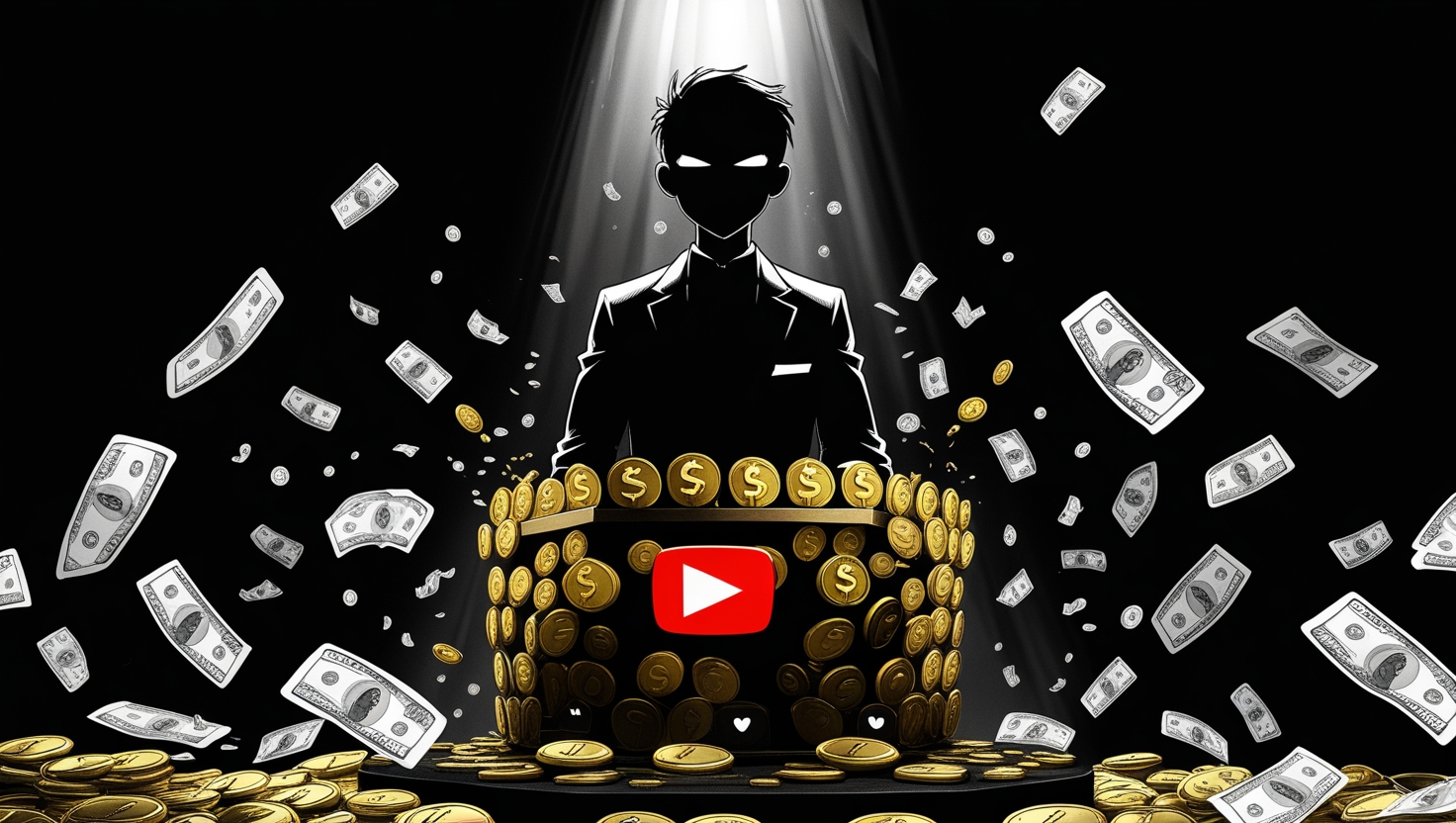If you’ve ever wondered, can you make money from YouTube without showing your face? you’re not alone. Many creative entrepreneurs and content creators are exploring faceless methods to generate income while keeping their identity private. In this comprehensive 2025 guide, we’ll dive deep into innovative strategies and effective techniques such as voice-over content, animation, screen recordings, and digital avatars. Whether you’re into storytelling or educational content, this guide is set to help you monetize YouTube without ever having a camera pointed at your face.

Why Choose a Faceless YouTube Channel?
For many creators, the idea of putting themselves in front of the camera is intimidating. However, this does not have to stop you from making a significant income on YouTube. In fact, faceless channels can often attract niche audiences since the focus shifts from personal appearance to the content quality. This approach not only helps maintain privacy but also allows you to experiment with various creative formats such as audio-based content, animated storytelling, and screen tutorials. Moreover, faceless channels can be scaled using modern AI tools designed for video editing and voice modulation, making the process both efficient and engaging.
Exploring Faceless YouTube Channel Ideas for Monetization
Have you ever considered diversifying your content without needing to record yourself? A number of innovative formats can help you achieve this. For example, channels that focus on voice-over storytelling, animated infographics, or educational screencasts have successfully built large audiences. Nowadays, integrating faceless YouTube channel ideas for monetization into your strategy can expand your creative horizons. Imagine guiding your viewers through detailed tutorials or narrating insightful commentary over dynamic motion graphics—all without ever showing your face.
Voice-Over Content and Podcast Videos
Voice-over videos and podcast-style content are among the most popular methods to stay anonymous while engaging with an audience. These videos can cover a variety of topics from self-help to technical tutorials. With scripting and professional audio editing, you can create an immersive experience where your voice does all the talking. The key is to invest in quality microphones and sound editing software so that your content looks professional and appealing, echoing the question: can you actually earn revenue on YouTube without ever appearing on camera?
Animation and Motion Graphics
Animations and motion graphics are a creative alternative that not only capture attention but also allow for detailed storytelling. By employing software like Adobe After Effects or accessible AI-driven animation tools, you can produce engaging videos that translate complex ideas into visual narratives. Even without a personal appearance, the content remains relatable and effective if the animation style is consistent and engaging. This method works perfectly for educational content or even product reviews, where the innovation of your visual style keeps viewers captivated.
Screen Recordings and Tutorial Videos
Another effective strategy is creating content based on screen recordings, often called screencasts. Whether you’re offering software tutorials, online course lessons, or game reviews, these videos provide substantial value to viewers. By using voice-over explanations alongside your screen recordings, you can build trust and authority in your niche. The combination of clear instruction and minimal personal disclosure answers the popular query: how to create YouTube videos without recording yourself?
Leveraging AI Tools for Faceless YouTube Channels
The rapid advancement of AI technology has revolutionized the way content is produced. Today, AI tools can assist in everything from script generation, voice modulation, video editing, to even generating realistic digital avatars. For creators questioning if it’s possible to monetize YouTube without showing their face, these AI innovations offer a seamless solution. Tools like Lumen5 for video creation and voice synthesis platforms like Descript or Murf provide a boost in quality and efficiency. With these resources, you can focus more on content quality and less on technical production issues.
How to Make YouTube Videos Without Recording Yourself
So, is it really possible to make YouTube videos without recording yourself? Absolutely! The key is to plan your content around formats that naturally exclude a personal on-screen presence. For instance, you might choose a combination of narrated slideshows, animated segments, and on-screen text to communicate your message. These methods can reduce performance anxiety and allow you to craft a polished video that maintains viewer interest. Creative transitions, engaging background music, and high-quality voice-overs are critical in keeping your audience engaged without ever seeing your face.
Personal Experiences and Practical Tips
Speaking from a personal perspective, adopting a faceless channel approach can liberate your creativity. I once grappled with the idea of being in front of the camera too, but switching to animated tutorials and voice-over guides opened a world of possibilities. Not only did it alleviate performance pressure, but it also allowed me to focus entirely on my content’s value. Have you experienced similar challenges when trying to present yourself on video? Taking cues from successful channels that employ faceless strategies might help you redefine your content creation process.
Comparing Content Types: A Quick Overview
| Content Type | Description | Pros & Cons |
|---|---|---|
| Voice-Over Videos | Uses professional narration paired with visuals such as stock footage or animations. | Pros: Engaging, low on-camera exposure. Cons: Requires quality audio equipment and editing skills. |
| Animation/Motion Graphics | Leverages animated sequences to illustrate ideas and stories. | Pros: Highly creative, visually appealing. Cons: Can be time-consuming and may require specialized software. |
| Screencasts | Records your computer screen while narrating the process or tutorial. | Pros: Excellent for educational content, software tutorials. Cons: Works best when paired with clear voice instructions. |
Building Trust and Engagement Without a Face
One of the biggest challenges for faceless creators is establishing a personal connection with the audience. The audience can get distant without a face. However, there are subtle ways to close the gap. For instance, having a regular digital avatar or animated personality can create familiarity over time. Adding interactive elements such as Q&A sessions, polls, and comment storytelling can invite audience interaction. These actions help overcome the initial factor of trust, proving that you can indeed build a profitable channel without disclosing your private identity.
Monetization Strategies for Faceless Channels
Monetization on YouTube goes beyond regular ad revenue—it’s also about clever brand deals, affiliate marketing, and even offering exclusive content. Since faceless channels are increasingly popular, advertisers now recognize that quality content, irrespective of on-camera presence, can achieve high engagement rates. Consider incorporating affiliate links, sponsored segments, or even exclusive courses that delve deeper into your chosen niche. By focusing on content value and transparency, you create an environment where monetization opportunities organically flow. If you’re curious about maximizing your online earnings, I highly recommend reading our in-depth guide on what youtube videos make the most money?.
The Future of Faceless Content and Emerging Trends
The YouTube landscape is constantly evolving, and so is the approach to content creation. With advancements in machine learning and augmented reality, faceless content is becoming more sophisticated. AI-driven personalization, real-time video editing, and advanced digital avatars are shaping the future of faceless monetization strategies. The question remains: can you make money from YouTube without showing your face? The steady growth of faceless channels suggests a resounding yes. As more creators invest in these innovative tools and strategies, viewers are likely to become even more receptive to diverse content formats that don’t depend solely on a visible presenter.

Wrapping Up: Is Faceless YouTube the Right Choice for You?
In short, if you’re hesitant to turn on the camera due to privacy or comfort concerns, you can rest assured that there are plenty of rewarding paths for you. The methods described here—from voice-overs and animation to leveraging mighty AI tools—demonstrate that you can actually create quality, engaging content without ever having to show your face.
Always remember that successful YouTube channels are founded on consistency, genuineness, and the desire to try new things. Therefore, whether your interest is in technology, education, or narrative, consider how you might innovatively implement these intangible tactics in building a profitable, successful channel in today’s rapidly evolving digital era.
If you’re looking to explore more avenues on how YouTube can be a lucrative platform, consider visiting our homepage at SmartEconomix for additional insights and expert advice. For external resources on the topic, check out the latest on TubeFilter, which regularly features trends and tips for modern YouTube creators.
Can faceless channels be as profitable as traditional channels?
Yes, many faceless channels are now among the top earners on YouTube. With the right strategies, regular posting, and engaging content, you can monetize your channel through ads, sponsorships, and affiliate marketing, just as effectively as any channel with on-camera presentation.
How do faceless channels build trust with viewers?
Trust can be established through consistent branding, quality content, and interactive engagement. Using a recognizable digital avatar and inviting your audience to participate through polls, Q&A sessions, and comments can enhance viewer loyalty.
How can I make YouTube videos without recording myself?
You can make YouTube videos by using screen recording software, animated slides, or digital avatars for narration. Paying attention to sound quality and using engaging graphics will also help maintain viewer interest.
